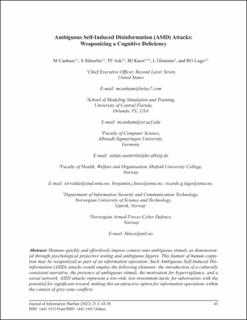| dc.contributor.author | Canham, Matthew | |
| dc.contributor.author | Sütterlin, Stefan | |
| dc.contributor.author | Ask, Torvald Fossåen | |
| dc.contributor.author | Knox, Benjamin James | |
| dc.contributor.author | Glenister, Lauren | |
| dc.contributor.author | Lugo, Ricardo Gregorio | |
| dc.date.accessioned | 2022-12-30T09:28:32Z | |
| dc.date.available | 2022-12-30T09:28:32Z | |
| dc.date.created | 2022-07-27T11:03:46Z | |
| dc.date.issued | 2022 | |
| dc.identifier.citation | Journal of Information Warfare. 2022, 21 (3), 43-58. | en_US |
| dc.identifier.issn | 1445-3312 | |
| dc.identifier.uri | https://hdl.handle.net/11250/3040027 | |
| dc.description.abstract | Humans quickly and effortlessly impose context onto ambiguous stimuli, as demonstrated through psychological projective testing and ambiguous figures. This feature of human cognition may be weaponized as part of an information operation. Such Ambiguous Self-Induced Disinformation (ASID) attacks would employ the following elements: the introduction of a culturally consistent narrative, the presence of ambiguous stimuli, the motivation for hypervigilance, and a social network. ASID attacks represent a low-risk, low-investment tactic for adversaries with the potential for significant reward, making this an attractive option for information operations within the context of grey-zone conflicts. | en_US |
| dc.language.iso | eng | en_US |
| dc.title | Ambiguous Self-Induced Disinformation (ASID) Attacks: Weaponizing a Cognitive Deficiency | en_US |
| dc.title.alternative | Ambiguous Self-Induced Disinformation (ASID) Attacks: Weaponizing a Cognitive Deficiency | en_US |
| dc.type | Journal article | en_US |
| dc.type | Peer reviewed | en_US |
| dc.description.version | publishedVersion | en_US |
| dc.source.pagenumber | 43-58 | en_US |
| dc.source.volume | 21 | en_US |
| dc.source.journal | Journal of Information Warfare | en_US |
| dc.source.issue | 3 | en_US |
| dc.identifier.cristin | 2039766 | |
| cristin.ispublished | true | |
| cristin.fulltext | original | |
| cristin.qualitycode | 1 | |
